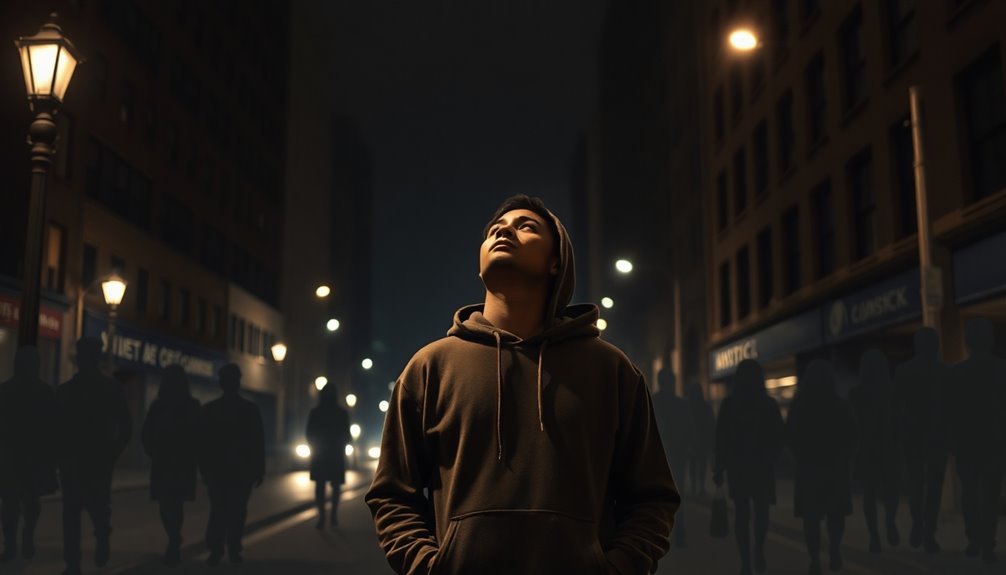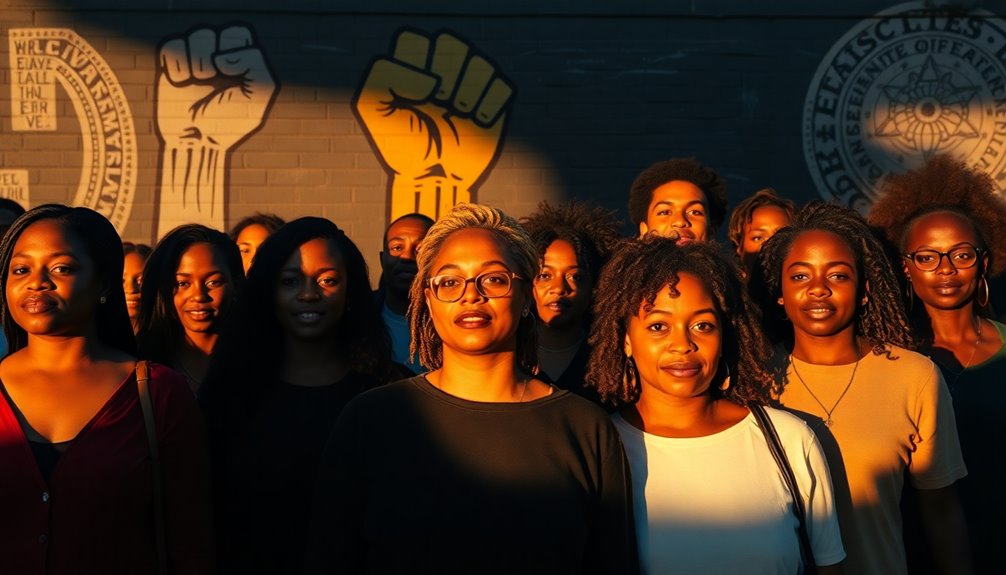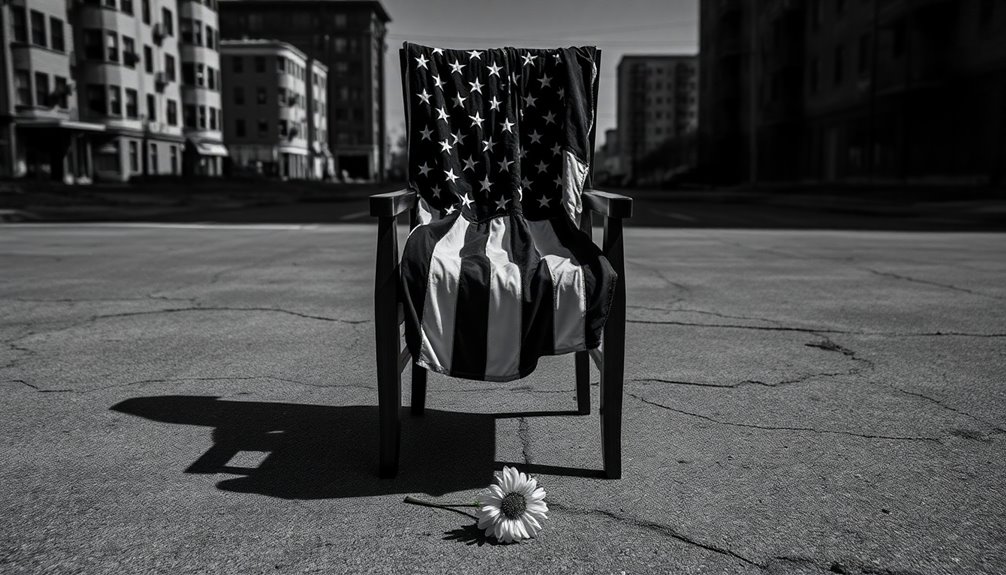In "Between the World and Me," Ta-Nehisi Coates writes a heartfelt letter to his son, exploring the brutal realities of racial injustice in America. Through personal experiences, he reveals how systemic racism impacts Black lives and critiques the American Dream as one built on oppression. Coates emphasizes the need to confront uncomfortable truths about violence and inequality. As you explore further, you'll uncover more insights into the profound implications of his reflections on race and identity.
Overview of 'Between the World and Me'

In "Between the World and Me," Ta-Nehisi Coates crafts a poignant letter to his son, Samori, that explores deeply into the realities of race and identity in America.
Coates reflects on the brutal legacy of racial injustice faced by Black bodies throughout American history. He shares his personal experiences, emphasizing the physical and emotional dangers that Black individuals encounter daily. The overlooked contributions of Black figures throughout history further illustrate the systemic oppression that persists today, highlighting the need for conversations about race to address these ongoing injustices.
The letter serves as a powerful reminder of the struggles against systemic oppression and the ongoing fight for dignity. Coates challenges the notion of inevitable progress, urging his son to understand that the fight for justice is far from over.
Through this intimate narrative, you gain insight into the complexities of being Black in America today. Additionally, Coates highlights the importance of confronting uncomfortable truths about race and privilege in order to foster understanding and drive change.
Key Themes Explored in the Book
"Between the World and Me" explores several key themes that resonate deeply within the context of racial injustice. Coates emphasizes the physical and psychological violence inflicted upon Black bodies, showing how systemic racism permeates everyday life. The resistance movements during World War II serve as a reminder that collective action can challenge and dismantle oppressive structures. He critiques the American Dream, arguing it's fundamentally tied to the oppression of Black individuals, a white dream built on historical subjugation. The narrative investigates how racial injustices devalue Black lives, complicating their identities. Additionally, Coates highlights police brutality as a mechanism of racial control, recounting harrowing experiences, like the murder of Prince Jones. The historical context of individual actions against tyranny, such as those seen in "Alone in Berlin," underscores the importance of standing up against injustice. Ultimately, the book serves as both a personal reflection and a powerful call to confront the uncomfortable truths about racism and our societal complicity. The themes of systemic racism explored in Coates' work echo those found in Richard Wright's "Native Son," emphasizing the ongoing struggle against oppression.
Ta-Nehisi Coates' Personal Experiences

Ta-Nehisi Coates' personal experiences reveal the harsh realities of violence and systemic oppression faced by Black individuals. You'll see how his encounters with danger challenged the belief that education alone could guarantee safety and success. His time at Howard University became a vital turning point, empowering him through a deeper understanding of Black culture and history. Additionally, his narrative resonates with themes of resilience amidst adversity that highlight the importance of courage in the face of systemic injustices. Coates' journey reflects the universal quest for stability amidst chaos, illustrating the profound impact of societal challenges on individual lives. His experiences echo the importance of creative expression as healing, demonstrating how art and storytelling can be powerful tools for processing trauma and fostering resilience.
Encounters With Violence
Growing up in Baltimore, Coates faced the ever-present threat of violence, an experience that deeply shaped his understanding of race and identity.
He recounts a terrifying encounter with a gun, illustrating the constant danger that Black bodies confront daily.
The tragic death of his friend Prince Jones at the hands of police officers starkly highlights the systemic racism embedded in American society.
Coates realizes that hard work and achievement don't guarantee safety for Black individuals, emphasizing the inherent risks they face.
Living under this constant threat of violence impacts his psyche, leaving him feeling disconnected, especially in largely white educational spaces.
Through his narrative, he reveals how this struggle informs his view of race in America, driving home the urgency of these realities.
Education's Irrelevance
While traversing the complexities of his youth, Coates often found that traditional education didn't reflect the harsh realities he faced as a Black individual. He experienced education's irrelevance firsthand, feeling that the curriculum overlooked systemic racism and the violence surrounding him.
A life-threatening encounter with a gun starkly illustrated this disconnect. Reading Malcolm X opened his eyes to the brutal truths of racial injustice, contrasting sharply with what he learned in school.
It was at Howard University that he truly engaged with Black culture and history, finding a context that resonated with his experiences. Coates' reflections highlight the need for an education that addresses the realities of systemic racism, empowering individuals beyond conventional frameworks.
Cultural Empowerment at Howard
Attending Howard University transformed Coates' understanding of his racial identity, as the vibrant community around him celebrated Black culture and history. This atmosphere of cultural pride and empowerment shaped his perspective on Black excellence and systemic racism.
You'd find yourself immersed in a unique environment where:
- Influential Black thinkers inspired critical thought
- Classes highlighted the importance of African American literature
- A sense of belonging replaced earlier feelings of isolation
- Discussions on identity flourished among peers
- Knowledge became a tool for resistance and understanding
At Howard, Coates embraced his heritage, realizing that understanding systemic racism was crucial.
This experience solidified his belief in the power of education and the importance of cultural identity in fostering empowerment.
The Impact of Systemic Racism

When you look at the historical context of racism, you can see how deeply it shapes personal experiences of trauma. These experiences aren't just isolated incidents; they highlight the broader societal implications of injustice that persist today. Understanding this impact helps you grasp the full reality of systemic racism in America. Additionally, the exploration of historical injustices in medical research underscores the pervasive nature of inequality and its lasting effects on marginalized communities. The contributions of unsung pioneers in social justice movements serve as a powerful reminder of struggles that continue to resonate today. Richard Wright's work serves as a powerful reminder of social justice struggles that continue to resonate today.
Historical Context of Racism
Systemic racism has roots that run deep in American history, shaping the very fabric of society.
It's essential to understand how this enduring issue manifests today:
- The legacy of slavery creates ongoing historical trauma.
- Racial violence remains a stark reality for many Black individuals.
- The myth of the American Dream often relies on the subjugation of marginalized groups.
- Institutions and policies enforce systemic racism, perpetuating inequality.
- Achieving racial equity requires confronting these historical injustices.
Ta-Nehisi Coates highlights these truths, illustrating how past atrocities affect modern life.
He urges us to acknowledge our collective history and the role of those in power, linking the suffering of previous generations to the continuous struggle for justice and dignity faced by African Americans today.
Personal Experiences of Trauma
Although many may believe that hard work and perseverance lead to success, the reality for Black individuals often tells a different story.
In his narrative, Ta-Nehisi Coates shares his personal experiences of trauma, illustrating how systemic racism creates a constant threat to Black bodies. Growing up in Baltimore, you witness firsthand the violence that looms over your community, shaping your understanding of safety and identity.
The tragic death of his friend, Prince Jones, at the hands of police epitomizes the racial violence that haunts many. Coates emphasizes that education and hard work can't shield you from this reality, exposing the psychological scars left by ongoing racial violence.
His reflections highlight the urgent need to confront these injustices for future generations.
Societal Implications of Injustice
The trauma experienced by individuals like Ta-Nehisi Coates highlights the broader societal implications of racial injustice. Systemic racism isn't just a personal struggle; it's a pervasive issue that shapes institutions and our daily lives.
Consider these points:
- Police brutality against Black bodies, like in the case of Prince Jones.
- The American Dream built on the oppression of Black individuals.
- Generational psychological trauma caused by ongoing racial violence.
- Policies designed to uphold white supremacy.
- The urgent need for reevaluating societal structures.
Injustice manifests in every facet of society, reinforcing a cycle that must be broken.
The Concept of the American Dream
While many view the American Dream as a universal aspiration for success and freedom, it's crucial to recognize that this dream has often been built on the exploitation and oppression of marginalized communities, particularly Black individuals.
Ta-Nehisi Coates argues that the American Dream functions as a "white dream," thriving on a racial hierarchy that marginalizes Black humanity. The pursuit of this dream for white Americans frequently comes at the expense of Black bodies, highlighting how systemic racism underpins the nation's prosperity. Furthermore, systemic discrimination has perpetuated racial, gender, and socioeconomic inequalities, making it essential to address these injustices. This dynamic echoes the historical narratives that challenge traditional views of success and highlight the complexities of the American experience.
Coates critiques the idea of racial progress, insisting that merely updating the American Dream isn't enough. True equity requires a thorough reevaluation that confronts these foundational injustices and dismantles oppressive structures impacting Black lives. Additionally, much like Charles Dickens' portrayal of class struggles, the narrative of the American Dream is intertwined with the realities faced by marginalized groups.
Reception and Critical Acclaim
How has Ta-Nehisi Coates' "Between the World and Me" resonated with readers and critics alike? The book's profound impact is evident in several ways:
- Winner of the National Book Award in 2015
- Topped The New York Times Best Seller list for nonfiction
- Praised by Toni Morrison for filling Baldwin's intellectual void
- Ranked 7th on The Guardian's 100 best books of the 21st century
- Selected for first-year reading programs at universities
Coates' raw honesty and emotional depth sparked essential conversations about racial progress and the experience of being Black in America.
Critics like A. O. Scott deemed it "essential," while David Remnick called it "extraordinary," solidifying its place in contemporary literature.
Adaptations and Cultural Significance
Adaptations of Ta-Nehisi Coates' "Between the World and Me" have greatly amplified its cultural impact, making the themes of racial injustice resonate even more powerfully.
The 2018 stage production at the Apollo Theater and the 2020 HBO special combined live performances with documentary footage, enhancing the emotional weight of Coates' message. Featuring around 20 celebrities and civil rights activists, the HBO adaptation underscored the widespread recognition of Coates' work in contemporary discussions about race.
Critics praised these adaptations as essential complements to the book, capturing the emotional depth and urgency of Coates' narrative. Together, they highlight the cultural significance of "Between the World and Me" in fostering essential dialogue about the experiences of Black Americans and the ongoing fight against racial injustice.
Further Reading Recommendations
To deepen your understanding of racial injustice, exploring further reading can provide valuable insights and perspectives.
Here are some recommended titles that address the struggles and triumphs of Black people throughout history, reflecting on human rights and the Civil Rights Movement:
- "We Were Eight Years in Power" by Ta-Nehisi Coates
- "Caste" by Isabel Wilkerson
- "The Warmth of Other Suns" by Isabel Wilkerson
- "The Autobiography of Malcolm X" by Malcolm X and Alex Haley
- "A Letter to My Nephew" by James Baldwin
These works will enhance your awareness of racial injustice and the ongoing fight for equality, offering powerful narratives and critical analyses that resonate with Coates' themes in "Between the World and Me."
Conclusion
As you close the book, the weight of Coates' words lingers in the air, a haunting echo of truths you've just uncovered. You can almost feel the pulse of history beneath your feet, urging you to confront the shadows of injustice. Each page turned reveals not just a story, but a call to action. Will you let this knowledge fade, or will you step into the light, challenging the darkness that still grips our world?



